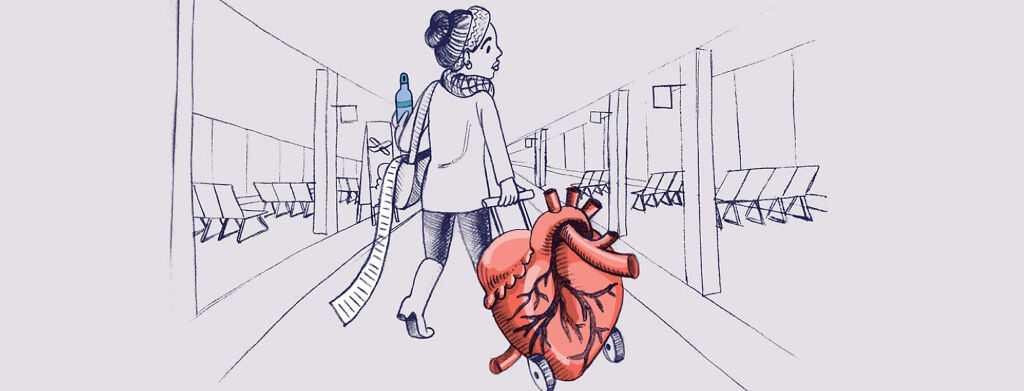Traveling With Pulmonary Hypertension
When I was first diagnosed with pulmonary hypertension (PH), I thought I had to be homebound and kiss my travel goals goodbye. Granted, at the time, it was too difficult for me to be anywhere but home.
There were so many extra travel concerns I had not thought about prior to my diagnosis. Now, I had to bring so many medical supplies on board with me. I had to get through TSA with a medication pump attached to me, I had to adjust to altitude, and I had to navigate huge airports with limited stamina. I didn’t know where to start!
Here are some of the hurdles I've faced, and how I navigated traveling with medication and oxygen.
This or That
Do you find traveling with cardiovascular disease difficult?
Arranging accommodations with airlines
Prior to my flight, I had to make accommodations with the airline. Most airlines need to know if you are flying with a portable oxygen concentrator (POC) ahead of time.
From my own personal experiences, some airlines require you to have a doctor’s note filled out and sent in. Some airlines don’t bat an eye, while others have wanted to check my POC and every battery prior to boarding. I honestly have had a different experience every time.
I've also made accommodations ahead of time to have a wheelchair from gate to gate. I felt so embarrassed by this; I hated it. I’m here to tell you there is NOTHING wrong with utilizing resources to make sure you feel comfortable. Don’t worry about the people staring at you along the way because you are "too young" to be pushed in a wheelchair. Airports are huge, and everyone is always rushing around. It can be exhausting walking from one gate to the next.
Accounting for changes in altitude
One of my first flights post-diagnosis had a layover in Denver, CO. I was traveling from below sea level, New Orleans, to the mile-high city. I could barely make it off of the airplane without immediately needing to rest once I saw the first chair at the gate. The difference in pressure and altitude was a silent weapon I did not anticipate.
From then on, I arranged for a wheelchair service to help me navigate the airport. I also felt so silly pre-boarding. I was so worried about what everyone would think of me. I just wanted to quickly get to my seat, turn on my POC, and hope no one would see my cannula under my mask. I wouldn’t have 1 ounce of concern about it now, but at the time, looking back, it was hard for me to accept this new way of travel.
Traveling with medications
I bring my medication and supplies in a carry-on with me on the plane. I always keep mine in a backpack, because I don’t want to run out of overhead bin space and then have to check my bag. Everything stays with me at all times.
If I am traveling for a week or longer, I bring every full bottle of medication with me. I have a separate pill container for each day. However, I always make sure I have plenty of extra medicine just in case. I don’t have the pleasure of skipping a dose, and I’m not about to find out what that looks like, especially while traveling.
I also keep a doctor’s note with me for my Remodulin pump. No one has ever asked for it, but I have it just in case.
A record of my medical history and medications
Lastly, I carry a small journal with pretty much my entire medical history — it’s color-coded and all! I list all of my insurance info, my diagnoses, my medications, doctors and contact info, etc. It is color-coded by condition. For example, my pulmonologist and PH meds are all the same color. That way, it is easier to identify which specialist is responsible for which diagnoses and medications. I keep everything in my head, so if I was ever unable to help myself, I try to make it as clear as possible.
I know that may sound a bit extreme, but when you live with a life-threatening condition, you can never be too prepared, in my opinion.
Getting through security with a Remodulin pump
Getting through security is a smoother process than I anticipated with my Remodulin pump. You can go through the normal routine. Once you go through the scanner, they will ask you to wipe your hands on your pump, and then they will swab your hands.
One thing to be mindful of is your outfit. I wear my pump in a belt strap around my waist. I’ve always had to show my pump and be patted down in that region, so you want to make sure it is easily accessible.
Don't let your diagnosis stop you
As trips continued, I slowly dropped my needs. I let go of the POC, and I didn’t need the wheelchair anymore to navigate the airport. After 3 years, I finally completed my first solo trip without a single hiccup!
Don’t let your diagnosis stop you from doing the things you love! While accessibility still has a ways to go, we have to also look back and appreciate how far we have come!

Join the conversation